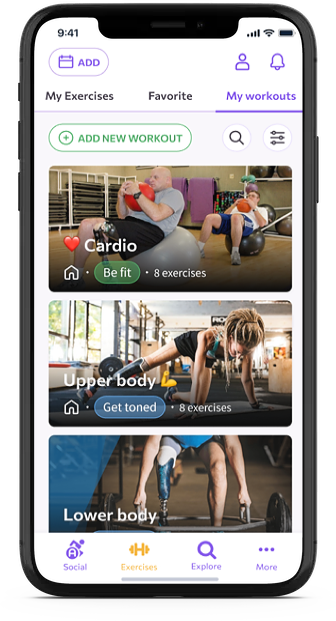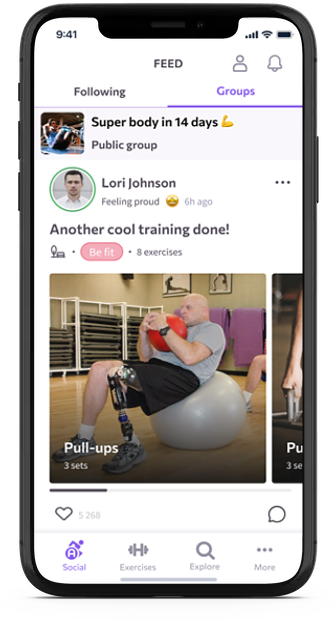Ali Jawad is a British Paralympic powerlifting champion, and he has a conviction: “Exercise must be seen as something for all, regardless of impairment.”
Jawad’s belief is the reason he joined forces with his former agent and fellow British athlete Sam Brearey to launch Accessercise, a fitness app for people who want to exercise despite their disabilities. The startup was among the Startup Battlefield 200 cohort at TechCrunch Disrupt 2023.
In its first onboarding step, Accessercise asks users about their disabilities, such as a missing upper or lower limb. The next questions ask them about their current level of exercise, and whether they need somebody to assist them.

Image Credits: Accessercise
The onboarding process is key to what happens next: In Accessercise, each disability is specifically supported.
“If you have one leg, you’ll only see videos which are scientifically valid and relative to you so they’re proven to be safe and to help you, and they’ll be demonstrated by somebody who also has one leg,” Brearey told me. “That’s really important to not only be relatable, but also to make sure that we’re being very specific in our support [of] each different impairment.”
A focus on empowerment
Because Accessercise focuses on empowerment, it doesn’t come with pre-built routines. Instead, users can pick and choose from the existing videos to build their own training plans, Brearey said. “You can build your own workouts, you can schedule them [in] your calendar, you can set reminders, you can filter exercises based on where you want to train, what muscle groups you want to train, how difficult you want it to be and what equipment you have available.”
To help users stick to their training, Accessercise also includes social features such as sharing and liking comments, as well as groups. These can be around a specific impairment or training goal, but also geographical.

Image Credits: Accessercise
Geography is also part of what Brearey describes as Accessercise’s third major feature, its Explore section. At the moment, it is a map of fitness facilities in the U.K., with some basic information on their accessibility level, but the startup plans to add more details over time, and also use this as a push for more gyms to take special needs into account.
Globally, 1.3 billion to 1.85 billion people are estimated to be living with at least one disability, according to a recent white paper from the Perkins School for the Blind. There are many barriers that prevent them from exercising, but lack of will is rarely one of these.
“We know that the vast majority of the disabled community wants to be more active — 81% [do] — and we know that they are twice as likely to take an opportunity if it’s presented to them compared to an able-bodied individual. The only real missing piece was somebody willing to provide that resource, knowledge and empowerment to them, so that’s exactly what we’ve done,” Brearey said.
Lack of adapted training advice still remains an issue, which is why the startup is partnering with fitness education company Future Fit to help coaches get qualified to support people with disabilities. That’s also why Accessercise’s videos are original content; there was no alternative for scientifically validated training.
“During COVID, for example,” Brearey said, “if you were able bodied and you wanted to stay fit during lockdown, you would go on YouTube, type in ‘Joe Wicks,’ or type in ‘press up’ or ‘workout’ or whatever, and have hundreds of thousands of options. But if you go on YouTube, and you type in ‘one leg press up,’ there’ll be maybe 10 videos, nine of which are filmed by people that aren’t qualified.”
The pandemic played a big part in Accessercise’s original story. At the time, Jawad was getting ready for the Tokyo Paralympics, but these were delayed by one year, and he started looking into ways to help the disabled community be more physically active. This also resonated with Brearey: A retired professional sailor turned sports agent, he specialized in underrepresented sports, with a client roster that included several paralympians.
When it came to building the app, Brearey leveraged his connections in Ukraine, where he lived for five years and where Accessercise’s third co-founder came from; a lawyer, Yulia Kyrpa said she stepped away from her role due to “critical strategic disagreements related to the company’s management.” As for Brearey, he fled Ukraine when the war escalated, but describes it as a very important part of his life. That’s also true for Accessercise: All of its marketing and development are still outsourced to people in Ukraine.
Accessercise on the global stage
Making its content available to Ukrainians for free is also part of Accessercise’s plans, but its commercial expansion goals are broader, and imminent. Its targets include Brazil, as well as other English-speaking countries than the U.K., including the U.S. later this year.
Brearey himself is planning to relocate to the U.S. and move the company there. Accessercise also recently said that it was on the verge of closing “its first institutional funding round.” In late 2022, it had already received funding from Australia’s Cerebral Palsy Alliance Research Foundation (CPARF).
More money would help Accessercise expand globally and develop several app sections that are currently marked as upcoming: nutrition, shop, blogs and podcasts. The startup hopes to launch all of these in the next few months and diversify its revenue sources, Brearey said. Besides e-commerce revenue from its shop, where it will sell adapted training items, it also plans to make money through advertising and targeted sponsorships.
Expansion and new features aside, Accessercise is also planning to use its upcoming funding for a “big marketing push” to grow the user base it has acquired organically. With some 2,100 active users before Disrupt and a highly underserved target audience, it still has a lot of space to grow.
The app uses a freemium model, and its subscription is priced at £11.99 for one month ($14.61), going down to £5.41 a month ($6.64) with a 12-month plan.
This article was updated to amend on January 30, 2024 a reference to Accessercise’s third co-founder.
